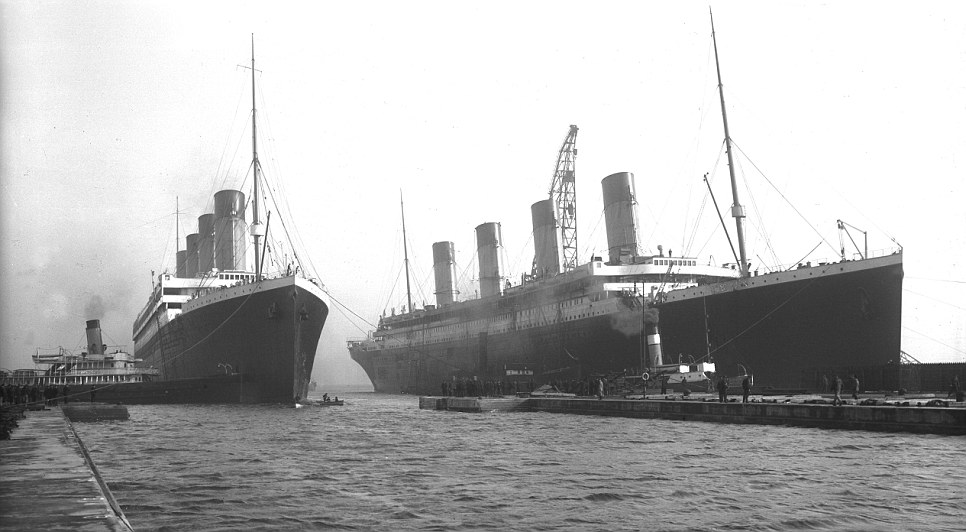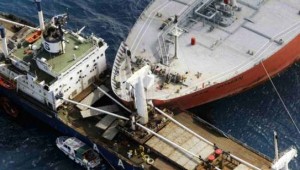
You must have heard of sister concerns and sister firms but do you know what is a sistership in marine terminology?
Well we know that ship is considered as a female gender, but what about the sistership thing as such relationships are more heard in terms of human beings being correlated in specific ways.
The concept of sister ship is very commonly used in the marine world. Many famous ships in history have had a sistership. But let us begin with how to define one such ship.
In the simplest of terms, a ship that is identical to another ship in design is called a sistership. The super structure, hull and layout are more or less the same.
Both the ships being very similar to each other are called sister ships. The concept of sister ships is more common in war ships than in any other type of ships.
Half Sisters
There is also a concept of half sisters in ships. These ships are of same class but have certain basic differences.
Legally, in terms of marine law terminology, the sisterships term is also associated with two identical ships that belong to the same owner. The law also states that arresting any one of the sister ships is the same as arresting the other. In case of accidents or claims arresting any one of the sister ship is fine as they belong to the same owner.
A regulation was passed in 1981 by the English High Court. This regulation clearly stated that the offending ship and its sistership is the same when it comes to the beneficial ownership part.
The law clearly states that the high court of any country has the jurisdiction to arrest the sister ship for securing any maritime claim. This law has made it possible to reduce the complications of many maritime claims. The ownership of the sister ships must be the same. This is determined by the shares that are owned by an individual in the ship. Unless the ownership is same the ships cannot be considered as sister ships.
The concept of sister ships is very common in the marine world. Especially in the international trade, this concept also helps to control the operation of the ships. Most of the famous ships in history and even today have a sistership. The famous Titanic had a sister ship named Britannic.
Key Characteristics
- Design and Construction: Sister ships are designed based on the same plans and are constructed in the same shipyard. They have nearly identical physical attributes, including hull shape, engine type, cargo capacity, and superstructure.
- Operational Efficiency: Having a fleet of sister ships allows for standardized training, maintenance, and operations. Crew members can easily transfer between sister ships with minimal additional training, and spare parts can be shared across the fleet, reducing inventory costs.
- Economies of Scale: Building multiple ships to the same design can result in significant cost savings for the shipbuilder and the shipping company. Bulk purchasing of materials and equipment, streamlined production processes, and reduced design costs all contribute to these savings.
- Fleet Management: Shipping companies benefit from operational consistency and flexibility with a fleet of sister ships. It simplifies fleet management and logistics, as similar ships can be deployed interchangeably based on demand and availability.
Examples in Practice
- Container Ships: Major shipping lines often commission series of container ships that are sister ships. These vessels are optimized for carrying standardized shipping containers and have similar loading, unloading, and handling processes.
- Tankers: Oil and chemical tankers are frequently built as sister ships. This ensures uniformity in safety and environmental compliance standards, which is crucial for transporting hazardous materials.
- Cruise Ships: In the cruise industry, sister ships are common. Cruise lines build multiple ships with the same layout and amenities, providing a consistent passenger experience across their fleet.
Notable Sister Ships
- The Titanic and Her Sisters: The RMS Titanic had two sister ships, the RMS Olympic and HMHS Britannic, built by the same shipyard (Harland and Wolff) for the White Star Line. These ships were nearly identical in design, although modifications were made over time.
- Maersk Triple-E Class: The Maersk Triple-E class is a series of large container ships operated by Maersk Line. These ships are designed for efficiency and environmental sustainability, and there are multiple vessels in the class that are considered sister ships.
Importance in the Merchant Navy
- Standardization: Sister ships standardize the design and operation of a fleet, making it easier to manage and operate.
- Training: Crew training can be streamlined, as the crew can transfer their skills and knowledge between sister ships without significant retraining.
- Maintenance and Repairs: Maintenance procedures and spare parts inventory are simplified, as the same parts and procedures apply to all sister ships.
- Operational Flexibility: Shipping companies can easily shift operations and reassign vessels as needed, without worrying about compatibility issues.
In summary, sister ships in the merchant navy provide significant operational, logistical, and economic advantages to shipping companies. They facilitate standardization, reduce costs, and enhance fleet management efficiency, contributing to smoother and more cost-effective maritime operations.
+++
Sister Ships: A Vital Concept in the Maritime World
When discussing ships, we often hear terms like “sister concerns” or “sister firms,” but the maritime term sistership is less commonly understood outside the marine industry. While ships are traditionally referred to in the feminine, the concept of sister ships extends beyond mere linguistic conventions and plays a crucial role in shipbuilding, operations, and maritime law.
This article explores the fascinating world of sister ships, their design, legal implications, operational benefits, and historical significance. By the end, you’ll understand why this concept is indispensable in the global maritime industry.
Defining a Sister Ship
In simple terms, a sister ship is one that shares nearly identical design and construction characteristics with another ship. These similarities extend to elements like the superstructure, hull design, layout, engine type, and other technical specifications. Sister ships are often constructed in the same shipyard using the same blueprints, ensuring consistency across the fleet.
While the concept is common across various types of vessels, it is especially prevalent among warships and merchant vessels. This standardization facilitates ease of operation, maintenance, and management.
Half-Sisters: A Related Concept
A half-sister ship is a vessel that belongs to the same class as another ship but differs in some basic characteristics. These differences might include variations in design, dimensions, or technical specifications. Half-sisters share a degree of similarity but are not as identical as true sister ships.
For instance, two cargo ships designed for the same purpose but featuring different engine types or hull modifications would be considered half-sisters. This concept allows some flexibility in shipbuilding while retaining the benefits of standardized design.
Sister Ships and Maritime Law
Beyond their design similarities, sister ships have significant implications in maritime law. The term is legally used to describe two or more ships that are not only structurally identical but also belong to the same owner. This ownership connection has critical consequences for legal and financial matters in the shipping industry.
Arresting a Sister Ship
One of the most notable aspects of maritime law is the ability to arrest a sister ship in the event of claims or disputes. For example, if a maritime claim is filed against one ship, the court can detain its sister ship as collateral, provided they share the same beneficial ownership. This legal principle was firmly established in 1981 by the English High Court, which ruled that a sister ship could be treated as the offending ship for securing maritime claims.
This regulation simplifies the resolution of maritime disputes and ensures claimants have a means of securing compensation. However, for the arrest to be valid, the ownership of the ships must be identical. Ownership is typically determined by analyzing the distribution of shares held in the ships. If the ownership differs, the vessels cannot be considered sister ships under maritime law.
Key Characteristics of Sister Ships
1. Design and Construction
Sister ships are built using the same plans and often in the same shipyard. Their similarities include:
- Hull design
- Superstructure layout
- Engine type and performance specifications
- Cargo capacity or passenger accommodations
This uniformity ensures that sister ships perform similarly and meet the same operational standards.
2. Operational Efficiency
Sister ships provide significant operational advantages:
- Streamlined training: Crew members can easily transition between sister ships with minimal additional training.
- Shared spare parts: Maintenance becomes more cost-effective, as spare parts are interchangeable.
- Consistent performance: Uniformity in design leads to predictable operational outcomes.
3. Economies of Scale
Building multiple ships to the same design results in cost savings for shipbuilders and operators. Bulk purchasing of materials, reduced design costs, and standardized construction processes contribute to these savings.
4. Fleet Management
Shipping companies benefit greatly from standardized fleets. Sister ships can be deployed interchangeably, allowing for greater flexibility in operations and logistics.
Examples of Sister Ships in Action
Sister ships are prevalent across various types of vessels, from cargo ships to luxury liners. Here are some notable examples:
1. The Titanic and Her Sisters
The RMS Titanic is perhaps the most famous ship in history, but it was not a standalone marvel. It had two sister ships, the RMS Olympic and HMHS Britannic. All three were constructed by the Harland and Wolff shipyard for the White Star Line. While they shared many design features, each ship had its own story:
- The Olympic served as a passenger liner and troop transport during World War I.
- The Britannic was converted into a hospital ship during the war but tragically sank after hitting a mine.
- The Titanic infamously sank on its maiden voyage in 1912.
2. Maersk Triple-E Class
The Maersk Triple-E class represents a modern example of sister ships. These ultra-large container ships are designed for maximum efficiency and environmental sustainability. By building multiple vessels with the same design, Maersk ensures consistent performance and simplifies fleet operations.
3. Cruise Ships
The cruise industry frequently employs the concept of sister ships to offer consistent passenger experiences. For instance, Royal Caribbean’s Oasis of the Seas and Allure of the Seas are sister ships with identical layouts, amenities, and capacities.
Sister Ships in the Merchant Navy
The merchant navy relies heavily on sister ships for various operational and logistical benefits. Below are some ways sister ships enhance efficiency:
1. Standardization
A fleet of sister ships simplifies operations by standardizing design, training, and maintenance. This uniformity reduces complexities in day-to-day operations.
2. Training
Training crew members is more straightforward when sister ships are involved. Knowledge and skills gained on one vessel can be directly applied to its sister ships, minimizing retraining efforts.
3. Maintenance and Repairs
Sister ships share spare parts and maintenance procedures, reducing costs and logistical challenges. For instance, a shipping company can stock a single type of spare part to service multiple vessels.
4. Operational Flexibility
With sister ships, shipping companies can reassign vessels based on demand without compatibility concerns. This flexibility is especially valuable in the dynamic world of international trade.
The Economic Advantages of Sister Ships
Sister ships offer several financial benefits:
- Lower Construction Costs: Shipbuilders save money by using the same design and materials across multiple ships.
- Reduced Downtime: Standardized maintenance procedures and interchangeable parts ensure quicker repairs.
- Improved Fleet Utilization: Identical ships can be deployed interchangeably, optimizing fleet usage.
Challenges of Sister Ships
Despite their advantages, sister ships are not without challenges:
- Design Flaws: If a design flaw is discovered in one sister ship, it is likely present in all others, potentially affecting an entire fleet.
- Over-Standardization: Excessive reliance on a single design may limit operational flexibility in certain scenarios.
- Initial Costs: Building multiple ships simultaneously requires significant upfront investment.
The Future of Sister Ships
As maritime technology advances, the concept of sister ships is evolving. Innovations in shipbuilding, such as modular construction and automation, are making it easier to build fleets of sister ships with even greater precision and efficiency. Environmental concerns are also driving the development of eco-friendly sister ships that adhere to stringent sustainability standards.
Additionally, digital technologies like artificial intelligence and blockchain are enhancing fleet management, allowing shipping companies to optimize operations across sister ships more effectively.
Conclusion
Sister ships are a cornerstone of the maritime industry, offering a blend of standardization, efficiency, and operational flexibility. From the RMS Titanic and its sisters to the cutting-edge Maersk Triple-E class, sister ships have proven their value time and again.
Whether facilitating international trade, streamlining fleet management, or enhancing passenger experiences, sister ships play a vital role in the world of shipping. Their significance extends beyond physical similarities, influencing maritime law, economics, and technological advancements.
As the maritime industry continues to innovate, the concept of sister ships will undoubtedly remain integral, shaping the future of global shipping and commerce.
Image Courtesy: Daily Mail UK
What Is A Sistership?,





